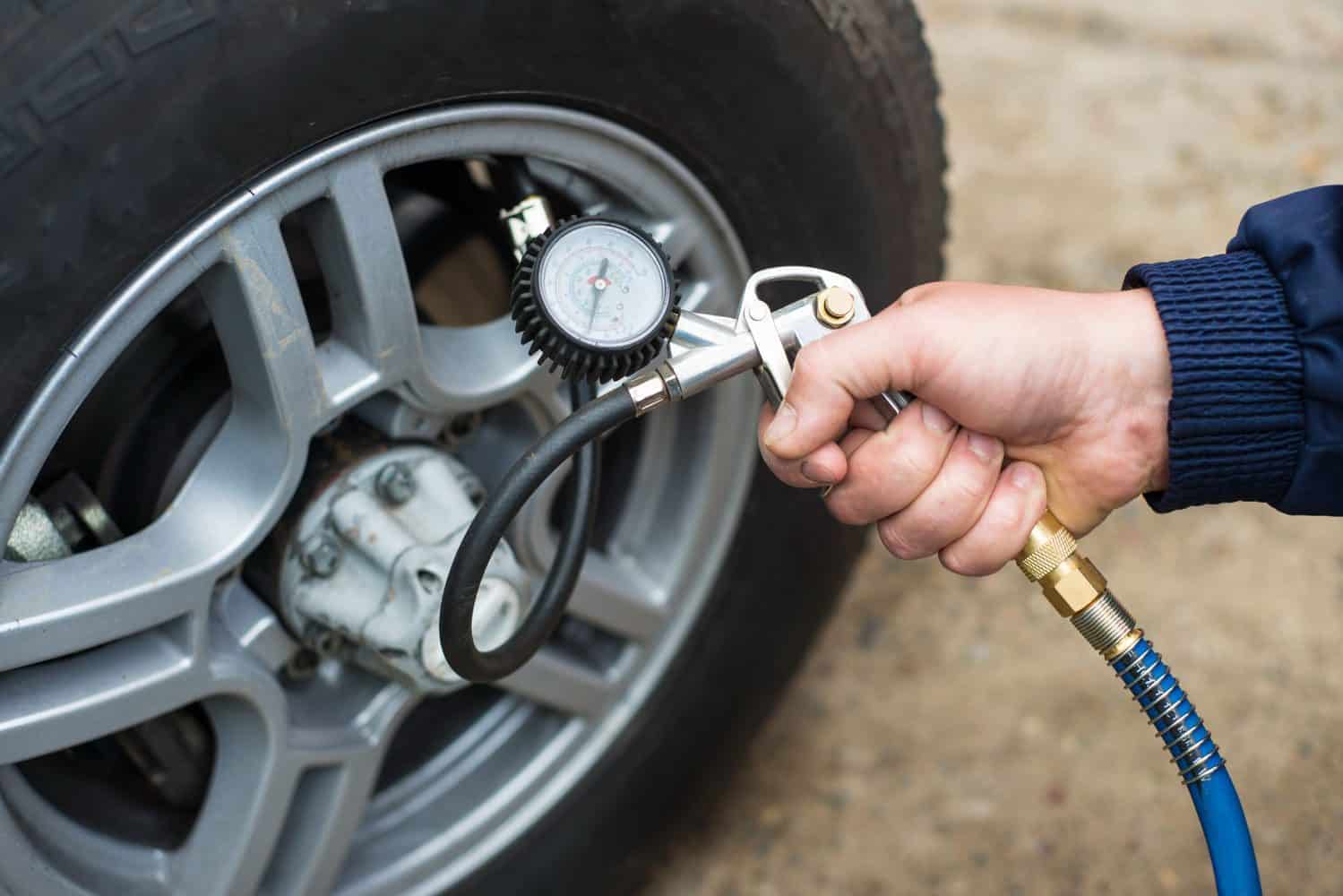Keeping your Camper Trailer packed correctly with most of the weight towards the front of the trailer is very important. So is making sure it is well maintained, the brakes are correctly adjusted, the shock absorbers and their rubbers are still working, and the tires are in good order are all fundamental issues you must monitor.
The safety checks need to ensure that the travel trailer tire pressure is correct for the model travel trailer, the load it will be carrying, and the roads on which you intend to travel. Proper tire pressures differ by travel trailer but tend to average between 50psi and 80psi.
Each manufacturer and model of the trailer will have a prominent notice displayed showing the recommended travel trailer tire pressure for each circumstance. Do not be afraid to change the travel trailer tire pressure during a trip to cope with the next road stage on which you will travel.
The Best Travel Trailer Tire Pressures Range From 50psi To 80psi
The pressure you pump your travel trailer tires to is very important.
Travel trailer tires have a tremendous job to do. They often stand unused for an extended period waiting for the weekend camping trips.
When tires are not used for a long time, the cool air will slowly escape due to the porous nature of the tire itself or due to them not being fully airtight at, or around, the valve stem or between the tire and rim.
After sitting in this condition, they are expected to accept a refill of air pressure and transport the travel trailer safely, over considerable distances, on different road surfaces, and at varying speeds. Mainly they achieve this safely and without any disruption.
It is, however, not uncommon for travel trailer tires to fail, and if this happens at high speed or on treacherous terrain, the consequences can be catastrophic. They may damage the travel trailer and even the tow vehicle.
Because of this, you must look after your travel trailer’s tires, ensuring that they stay in good shape and that the tire pressures are correct.
There are two tire pressure recommendations you will see on your travel trailer.
- The first is a notice inside the travel trailer, possibly inside a compartment or attached to the chassis; this is a federal requirement in some countries.
- The second is a value shown on the sidewall of the tire.
You must pump the travel trailer tires to the value shown on the notice in the travel trailer and not the one printed on the tire.
The value shown on the tire sidewall is the max cold pressure; this is the maximum pressure the tire structure can safely handle when cold. It will be a significantly higher value than the pressure shown on the travel trailers’ notice.
The notice displaying the correct tire pressure of the travel trailer may be missing. Look in the owner’s manual or contact the dealer to get accurate information.
Factors Affecting The Best Tire Pressure On Travel Trailers
You should consider several factors, particularly if you don’t have access to the manufacturer’s data.
The Weight, The Travel Trailer, Is Carrying
The tire pressure of most travel trailers should be set between 40 and 65 psi for travel trailers that weigh between 1,500 lbs to 15,000 lbs.
Check out this Portable Air Pump from Amazon.
If you increase the load, you must also increase the pressure in the tires.
The inflation pressure imprinted on the tire’s sidewall is the maximum pressure for that tire while carrying a load, and under no circumstances should it be exceeded.
The Roads You Intend On Travelling With Your Travel Trailer
Higher pressures are acceptable and recommended for higher speed traveling over paved surfaces. On these surfaces, the tires flex less, so the heat builds up more slowly. The harder tires provide a more stable ride at these speeds.
If you are traveling on very sharp gravel or slate-based roads, it is easier to suffer a puncture with tires pumped to high pressure because they are less flexible, and the sharp rock edges can cut through them very quickly.
If you do travel on different surfaces, it is recommended that you carry a tire pressure testing kit and a portable inflation kit. Before starting on the gravel surfaces, reduce the pressure by up to 30%, which increases the tire’s flexibility, and it, therefore, enhances its ability to handle the sharp rocks.
If you regularly travel on surfaces like these, it may be a good idea to consider changing the tires to better suited Light Truck (LT) tires. These have a thicker carcass and stiffer sidewalls that can better cope with adverse conditions.
If you travel on rough surfaces, it’s a good idea to reduce your speed. This is a good safety practice, and it will help to prevent swaying due to loss of traction.
Reducing the pressure in the trailer tires will result in the tires flexing more which builds up heat. Reducing the speed at which the travel trailer is being towed will reduce the number of times the tires flex; this reduces the heat build-up as there is more time to dissipate the heat between flexes.
Adjust The Travel Trailers Tire Pressure For The Weather
As we know, air pressure expands and contracts based on temperature.
In cold weather, add 3 Psi to the pressure indicated by the manufacturer, which will provide a margin to cover the contraction of the air pressure due to the cold.
The Following Lists Some Good Housekeeping Habits For Travel Trailer Tires
To make sure you travel in complete safety and that the tires continue to give years of wear, we recommend that you follow the checklist below.
- Before leaving on a journey, check the travel trailer’s tire pressure. Both tires on each axle must be set to the same level.
- Always carry an air compressor to check and fill the tires at your destination or en route if you need to adjust the pressure for different road surfaces.
- Always set the tire pressure to the manufacturer’s recommended value, and never follow the “advice” of someone who uses a different travel trailer. The tire pressures required by other travel trailers will often be different and are related to the travel trailer’s loaded weight capacity.
- If you can, it is suggested that you install an RV travel trailer pressure monitoring system to give you a live status of the travel trailer tire pressures.
- Never tow a travel trailer at high speeds with the incorrect tire pressures. At high speeds, too low a pressure will cause the tires to flex excessively, making the travel trailer unstable.
If the road surface is very rough with sharp gravel or shale, a tire pressure that is too high will result in punctures or a blowout.
- If you are replacing the tires, and they will be used for the same purpose as the previous ones, ensure the new tires have the same specifications as those you are replacing.
Conclusion
Deciding on the correct tire pressures in Travel Trailers and tow vehicles has caused many a discussion over a beer. The starting point should always be the manufacturer’s recommended Psi, and any variations to this should be based on the circumstances in which you tow your travel trailer.
Adjusting the pressure outside of the recommended values makes the travel trailer more prone to instability, excessive tire wear, or in extreme cases can cause severe damage or injury.
Good luck, and happy camping!
Check out our article on: How To Change A Tire On A Single Axle Travel Trailer?

